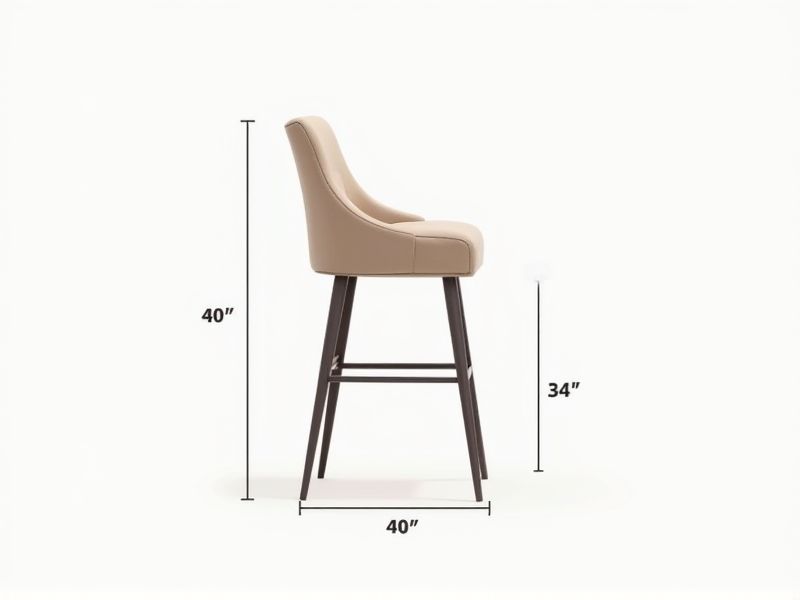
When selecting a bar stool, it's important to know the standard dimensions to ensure a comfortable fit for your counter or bar. Most bar stools have a seat height between 28 to 30 inches, which pairs well with bar heights of 40 to 42 inches. The seat width typically ranges from 15 to 18 inches, providing enough room for most adults. For optimal spacing, leave about 6 to 10 inches between each stool to allow easy movement and access.
Seat Height
The standard seat height for bar stools typically ranges from 28 to 32 inches, designed to complement counters or bars that stand 40 to 42 inches tall. When selecting a bar stool, aim for a distance of 10 to 12 inches between the stool seat and the underside of the countertop to ensure comfortable seating. For shorter or taller individuals, consider options with adjustable heights to provide versatility for different users. Investing in stools that fit these standards enhances your seating experience and maintains a cohesive aesthetic in your space.
Total Height
The standard total height of a bar stool typically ranges from 28 to 32 inches (71 to 81 cm) for counter-height seating. For bar-height stools, expect a total height between 30 and 36 inches (76 to 91 cm). This measurement ensures that your bar stool comfortably aligns with a countertop height of 34 to 40 inches (86 to 102 cm), providing optimal ergonomics for seating. When selecting a bar stool, consider your countertop height to achieve the ideal seating arrangement for your space.
Seat Width
The standard seat width for a bar stool typically ranges from 15 to 18 inches, providing adequate space for comfort while sitting. A wider seat allows for enhanced relaxation, particularly during extended periods of use, making it ideal for social settings. When choosing a bar stool, consider the layout of your space; adjustable models can cater to varying heights of countertops or bars. For optimal enjoyment, ensure your bar stool complements both your style and functional needs.
Seat Depth
The standard seat depth for a bar stool typically ranges from 16 to 18 inches, which provides optimal comfort for sitting. A deeper seat may offer more relaxation but might also hinder shorter individuals from comfortably placing their feet on the ground. When selecting a bar stool, consider your height and the height of the bar or counter, as this ensures proper legroom is maintained, ideally around 10 to 12 inches between the seat and the counter. An ergonomic design with appropriate seat depth enhances the overall seating experience, making it essential for both residential and commercial settings.
Base Diameter
The base diameter of a bar stool typically ranges from 16 to 24 inches, providing stability and support for individuals weighing up to 300 pounds. A wider base enhances the stool's balance and reduces the likelihood of tipping, making it suitable for use in both residential and commercial settings. When selecting your bar stool, consider a base diameter that complements the height and design of your bar or counter, typically 40 to 42 inches high. An appropriate base diameter not only ensures safety but also contributes to the aesthetic appeal of your space.
Leg Spacing
The standard leg spacing for bar stools typically ranges from 24 to 30 inches apart, depending on the stool's height and design. Proper leg spacing ensures stability and comfort, allowing you to sit without feeling cramped. Manufacturers often recommend a distance of at least 12 inches from each leg to prevent tipping hazards. When selecting bar stools for your space, consider these dimensions to enhance both functionality and aesthetics.
Backrest Height
The ideal backrest height for bar stools typically ranges from 10 to 12 inches above the seat, providing optimal lumbar support for comfortable seating. A backrest of this height encourages better posture and reduces strain on the lower back, promoting longer sitting periods without discomfort. When selecting a bar stool, consider your counter height, which usually varies between 34 to 36 inches, ensuring the stool's backrest aligns well with the overall design aesthetic of your space. For your kitchen or bar area, a well-chosen backrest height can enhance both comfort and visual appeal.
Footrest Height
The standard footrest height for bar stools typically ranges from 7 to 12 inches above the seat, ensuring ergonomic comfort for users. A well-positioned footrest enhances stability and support, allowing you to maintain a relaxed posture while sitting. Bar stools designed for standard counter heights (34 to 36 inches) often feature footrests to accommodate these dimensions effectively. Proper footrest placement not only adds aesthetic appeal but also contributes to a more enjoyable seating experience.
Weight Capacity
The standard weight capacity for bar stools typically ranges from 250 to 300 pounds, accommodating a wide audience. When selecting a bar stool, consider materials like metal or hardwood, which often enhance durability and support. Specific designs may offer reinforced bases or wider seats to further increase stability and comfort. Ensure your bar stools not only match your aesthetic but also meet the necessary weight requirements for safety and performance.
Overall Stability
Overall stability in bar stools is crucial for ensuring user safety and comfort. A reliable bar stool typically features a sturdy base width ranging from 16 to 20 inches, which significantly reduces the risk of tipping. Materials such as solid wood or heavy-duty metal offer enhanced stability, with weight capacities often exceeding 300 pounds. When selecting a bar stool, consider models that include non-slip feet or wider supports to maximize stability and prevent sliding on various floor surfaces.
